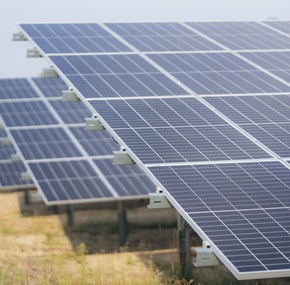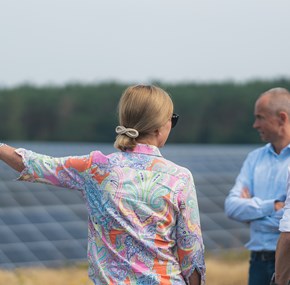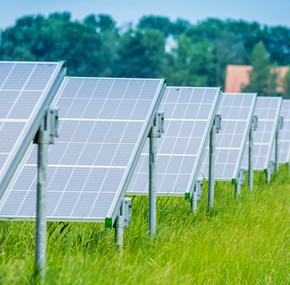This renewable energy source dominated the past decade
If the challenge of transforming the global energy system to a low carbon one seems daunting, you only need to look at renewable energy investment over the past decade! A new report by United Nations Environment Programme (UNEP) shows the incredible rise of renewable energy production – and one technology in particular reigns supreme.
Alright, no need to beat about the bush: It is of course solar power!
This is hardly a surprise to us at Obton, as we build our entire business on locating, developing and running solar PV facilities. But the findings in the recent report by United Nations Environment Programme (UNEP) and Bloomberg NEF might be a shock for some.
Of the massive 1,236 GW of new renewable energy capacity that was installed over the last decade globally, solar power accounted for almost half.
- This report makes for very encouraging reading. Within just ten years, solar power has moved from being seen as a somewhat risky investment to actually driving the change towards a low carbon future, says CEO of Obton, Anders Marcus.
This feat is even more remarkable when you consider that solar power even tops the list of new capacity for all major power generating technologies (both fossil and zero-carbon). The last decade saw 638 GW of solar installations, while power from coal in second place added 529 GW of new capacity. Wind and gas power take third and fourth place with 487 GW and 438 GW respectively.
- Ten years ago, no one would have believed that by the end of the century, solar would have attracted $1.3 trillion in investments. But it did. We saw the potential early and have been fortunate to work with far-sighted developers and financing partners who have helped us grow into one of the biggest solar investors in Europe, says Anders Marcus.
From zero to hero
To truly understand the gigantic leap made by renewables such as solar and wind power over the last decade, let us go back in time to January 2010.
Back then, wind and solar were – in the words of UNEP’s report – “dots on the horizon”. Between them, wind and solar accounted for only 4% of global power generating capacity – and with good reason.
- A decade ago, wind and solar power were relatively expensive ways of generating power. They relied heavily on government subsidies to be viable, says Anders Marcus. Furthermore, falling energy prices and sluggish economic growth after the financial crisis of the previous decade threatened the continuation of renewable energy investment.
Fast forward to the end of 2019, and wind and solar now account for a huge 18% of global power generating capacity.
- The last decade has seen a revolution in the cost of renewable energy production, explains Anders Marcus.
The cost revolution
The UNEP report also looked at the so-called levelized cost of electricity (LCOE) – a measure that allows comparison of different electricity generation methods. Here, the drop in the costs of renewable energy production has been remarkable.
In the second half of 2009, a megawatt-hour (MWh) cost $304 to produce with solar PV. Ten years later (in first half of 2019), the same MWh can now be produced for a mere $57 – an 81% drop in costs. By way of comparison, the costs (LCOE) of onshore and offshore wind dropped by 46% and 44% respectively over the same period.
- In many countries today, solar and wind are often the cheapest options when considering new power generating capacity, says Anders Marcus. He points to several factors behind this “cost revolution”.
- The drop in costs and technology innovations has been driven by fierce competition. Not only between manufacturers, but also between developers looking to cut overheads and win renewable energy auctions. The low financing costs of the last decade also plays a role in solar energy’s rise to prominence, he says.
Power-hungry China
The economic growth in China means an insatiable hunger for power. China is often criticized for still relying too heavily on coal to power its growth. However, the UNEP report clearly shows that this is only tells half the story:
- No other country has added as much renewable energy over the past decade as China. With more than 451 GW of renewable energy, China has added almost twice as much capacity as the whole of Europe, says Anders Marcus.
But in terms of halting climate change, China’s low carbon efforts are offset by its expansion of coal-powered electricity generation. Over the past decade, while China has added 200 GW of solar capacity, it has also added more than 200 GW of coal power.
Solar ready to dominate the next decade
Despite the impressive results of the past decade, Anders Marcus expects solar power to assume an even greater role in the coming decade:
- Solar power has spent the last decade growing up and can now compete on equal terms with most other energy sources. The corporate sector has been quick to grasp this, and we are already experiencing a rapid increase in power purchase agreements of solar and wind energy, he says.
A recent example of this is Obton’s contract with Canadian TC Energy Corp for the purchase of over half of the energy production of a 170 MW solar facility near Alberta.
- Demand and investment in solar energy will continue to increase. The only question is whether developers are able to meet the demand, says Anders Marcus.







